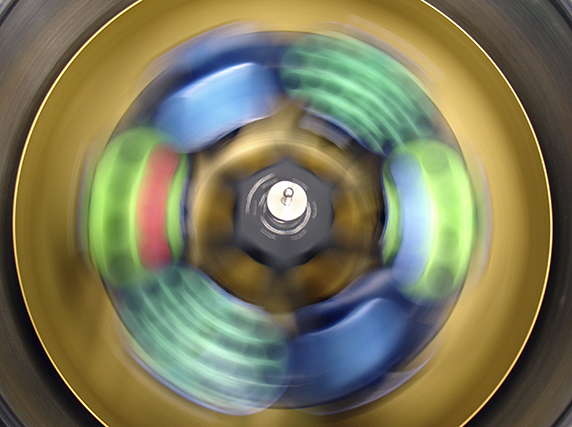JLR: Super-fast spins hurt lipoproteins
Sometimes the end doesn’t justify the means. In a recent paper in the Journal of Lipid Research, investigators describe how spinning high-density lipoproteins fast, a typical way to isolate them quickly, damages them. The finding suggests that the current understanding of the hydrodynamic properties and composition of HDL “is incorrect,” states William Munroe at the University of California, Los Angeles.

HDL, known as the “good cholesterol,” is an important lipoprotein in diagnosing cardiovascular disease. Its abundance in the bloodstream is considered to be a sign of good cardiovascular health, because HDL carries away cholesterol.
Ever since the discovery in 1949 that lipoproteins can be separated and isolated in an ultracentrifuge, spinning lipoproteins like HDL at speeds of 40,000 rpm or greater has been the norm. Samples often get spun at speeds of 65,000 to 120,000 rpm within 48 hours to hasten the isolation process.
But there have been whispers in the lipid community that the high speeds damage the molecules. So a trio of researchers at UCLA, led by Verne Schumaker, decided to see how speed affects HDL. “The phenomenon of HDL potentially exhibiting sensitivity to the ultracentrifuge speed is sometimes mentioned between lipoprotein researchers,” says Munroe, the first author on the paper. “However, there was little in the literature describing this phenomenon.”
In their JLR paper, Munroe, Schumaker and Martin Phillips showed that damage to HDL began as soon as the ultracentrifuge speed hit 30,000 rpm. Using mouse plasma samples, the investigators demonstrated that the damage got worse as the rotor went faster. Proteins, which are integral to the lipoproteins, got ripped out of the protein-lipid complexes, leaving few intact particles. “With enough gravitational force or time, this protein-deficient HDL undergoes further damage to lose lipid,” notes Munroe.
To try to circumvent the damage, the investigators tested out an alternative method for isolating HDL. They poured a potassium bromide density gradient over their sample. Next, they spun the gradient with the sample at a low speed of 15,000 rpm. Admittedly, the isolation took longer at 96 hours, but at least the amount of HDL that rose to the top of gradient was significantly higher than when using the conventional method.
Based on their findings, the investigators now want “to identify HDL-associated proteins that previous identification studies may have missed because certain proteins may have been completely lost from the recovered HDL particle during its isolation by ultracentrifugation,” says Munroe. “This may give insight into additional roles the HDL may participate in besides reverse cholesterol transport.”
Enjoy reading ASBMB Today?
Become a member to receive the print edition monthly and the digital edition weekly.
Learn moreGet the latest from ASBMB Today
Enter your email address, and we’ll send you a weekly email with recent articles, interviews and more.
Latest in Science
Science highlights or most popular articles

How a gene spurs tooth development
University of Iowa researchers find a clue in a rare genetic disorder’s missing chromosome.

New class of antimicrobials discovered in soil bacteria
Scientists have mined Streptomyces for antibiotics for nearly a century, but the newly identified umbrella toxin escaped notice.

New study finds potential targets at chromosome ends for degenerative disease prevention
UC Santa Cruz inventors of nanopore sequencing hail innovative use of their revolutionary genetic-reading technique.

From the journals: JLR
How lipogenesis works in liver steatosis. Removing protein aggregates from stressed cells. Linking plasma lipid profiles to cardiovascular health. Read about recent papers on these topics.

Small protein plays a big role in viral battles
Nef, an HIV accessory protein, manipulates protein expression in extracellular vesicles, leading to improved understanding of HIV-1 pathogenesis.

Genetics studies have a diversity problem that researchers struggle to fix
Researchers in South Carolina are trying to build a DNA database to better understand how genetics affects health risks. But they’re struggling to recruit enough Black participants.

